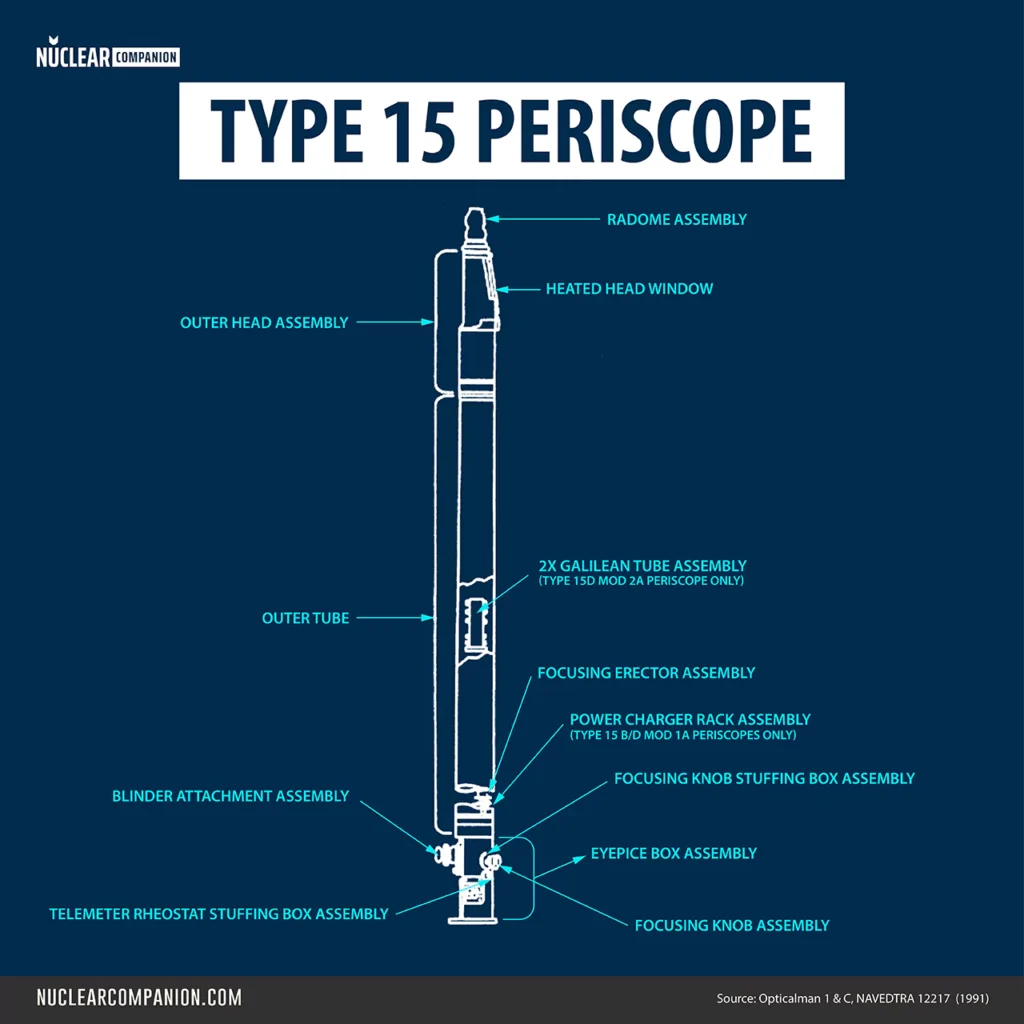Description
The Type 15L Periscope is a U.S. Navy general-purpose search periscope used exclusively on Trident (Ohio-class) submarines. This periscope is part of a shipset including the Type 8L Mod T, where the 15L is mounted to port, known as periscope No. 2, and the Type 8L to starboard.

Like the Type 8L Mod T, the Type 15L additionally functions as an optical instrument and an antenna mast. It has omnidirectional and direction-finding antennas and capability for Electronic Support Measures (ESM) reception. A Nikon F 35 mm camera and a television camera are used with this periscope.
The Type 15L was replaced by the AN/BVS-1(V) Photonics Mast Variant(PMV) aboard SSGNs.
Development
In 1974, the Naval Underwater Systems Center (NUSC) was designated by the Naval Sea Systems Command (NAVSEA) as the agent responsible for developing the Trident periscope shipset.
Although the Trident periscopes were initially conceptualized as derivatives of the existing Type 15 and Type 8 periscopes used on other SSBN-class submarines, they represented a significant advancement in periscope technology. Unlike their predecessors, the Trident periscopes were the first to be developed from a comprehensive Navy specification and to incorporate integrated logistics support from the outset.

Initially, the Trident periscopes were expected to consist of about eighty percent existing design and twenty percent new design. However, stringent requirements for integrated logistics support necessitated a major redesign, resulting in a final product that was approximately eighty percent new design.
In 1976, the Naval Sea Systems Command awarded a $6.9 million contract to the Electro-Optical Division of Kollmorgen Corporation, based in Northampton, Massachusetts, for the development and manufacture of a periscope system for the new Trident submarine program.
Kollmorgen, a company with a legacy of designing every submarine periscope system in service with the U.S. Navy, was tasked with delivering four shipsets of equipment and spares by the latter half of 1977 under the Trident contract. NUSC supervised and guided the development of these first fully documented and supported submarine periscopes.
By 1979, one of the initial Trident shipsets was delivered to NUSC for a year-long test program. NUSC personnel conducted comprehensive tests on the periscope’s performance, including optical, RF, and EMI/EMC assessments.
The first Trident submarine with the new periscopes, the USS Ohio (SSBN-726), went on sea trials in June 1981. It was commissioned later that year and embarked on its first deterrent patrol in October 1982, armed with 24 Trident C-4 SLBMs.
Operational Status
Operational in the following Platforms:
- Originally SSBN 726-743
- Currently SSBN 730-743
Contractor
- Originally, it was the Electro-Optical Division of Kollmorgen Corporation of Northampton, Massachusetts.
- Currently, L3Harris KEO of Northampton, Massachusetts.
Specification
Type: General-purpose search periscope
Functions:
– Optical instrument Antenna mast
– Equipped with omnidirectional and direction-finding antennas
– Capabilities for Electronic Support Measures (ESM)
Field of View:
– 32° at 1.5x magnification
– 8° at 6x magnification
Line-of-Sight Elevation Range: +60 to -10 degrees
Overall Length: 48 feet 7 inches
Optical Length: 46 feet (from the center of the eyepiece to the zero elevation line of sight at the head prism)
Gallery
Further reading
- Ohio-Class (SSBN-726) Ballistic Missile Submarines
- Ohio-Class (SSBN-726) Submarine Technical Specification
- Type 8L Periscope
Bibliography
- Friedman, N. (1989). The Naval Institute guide to world naval weapons systems. Annapolis: Naval Institute Press.
- Opticalman 1 & C. (1991). United States: U.S. Government Printing Office.
- Jane’s Weapon Systems. (1988). United Kingdom: F. Watts.
- Jane’s Major Warships Volume 1. (1997). United Kingdom: Jane’s Information Group.
- Merrill, J., Wyld, L. D. (1997). Meeting the Submarine Challenge: A Short History of the Naval Underwater Systems Center. United States: Department of the Navy.
Are there any images available showing the Nikon F camera fitted to this periscope?
I believe that I have one of the camera systems (Nikon F), but perhaps from around 1965-1970. Perhaps originating from USS Halibut.
Graham, thank you for your comment. At the moment, I am not aware of any published images showing a Nikon F camera fitted to the Type 15L periscope. If you do have images of the camera system and hold the rights to them, I would be glad to include one in the article, should you be willing to share. Best regards, Javier